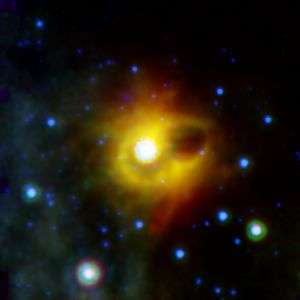Scientists find giant ring encircling exotic dead star

One of the most powerful eruptions in the universe might have spun an infrared ring around a rare and exotic star known as a magnetar, a highly magnetized neutron star and the remnant of a brilliant supernova explosion signaling the death throes of a massive star.
A paper published in the May 29 issue of Nature announces the detection of the elliptical ring or shell around the dead star known as SGR 1900+14. Observations obtained from NASA’s Spitzer Space Telescope in 2005 and 2007 suggest the ring was produced by a giant flare originally detected in 1998.
Stefanie Wachter, research scientist at NASA’s Spitzer Science Center at the California Institute of Technology, led the study, which links the origin of the magnetar to a nearby cluster of massive stars, whose light is dominated by two red supergiants at the center.
“Out of 400 billion stars in our galaxy, there are about a dozen magnetars that we know of,” says Donald Figer, professor at Rochester Institute of Technology’s Chester F. Carlson Center for Imaging Science and a co-author of the study. “Discovering the ring is groundbreaking because it discovers some other phenomenon associated with, and physically near, a magnetar. And when you know so little about an object, each new morsel you can gather up is very important.”
Figer is also part of a team, led by Rolf Kudritzki of University of Hawaii, who recently won time on the world’s largest telescope, the W.M. Keck Observatory, to make additional measurements of the magnetar.
“Magnetars possess magnetic fields a million billion times stronger than the magnetic field of the Earth,” Figer says. The magnetic field of a magnetar is one petagauss (10 to the 15th or 1,000,000,000,000,000 gauss) while, in comparison, Earth’s magnetic field strength registers at 0.5 gauss, the Sun at one gauss and a sunspot at about 1,000 gauss. These extreme fields stretch the very fabric of matter, contorting atoms into thin cigar-shaped structures.
An accepted model for magnetars was introduced in the early 1990s to describe the mysterious and frequent flashes of repeating gamma ray emissions first detected in 1979.
The stellar eruption may result from stress induced by the magnetic field dragging on the rapidly spinning star. A fissure in the surface of the magnetar creates a “starquake,” akin to earthquakes. The biggest variety of these eruptions can temporarily produce over a thousand times more energy than all of the stars in a galaxy.
Adds Wachter: “We think that the ring was created when a giant flare from the SGR (soft gamma repeater) carved a cavity into the dusty environment surrounding the magnetar, thus naturally explaining why the ring is centered on the magnetar.”
Wachter’s team also includes Enrico Ramirez-Ruiz from Astronomy and Astrophysics, Vikram V. Dwarkadas from the University of Chicago, Chryssa Kouveliotou from NASA/Marshall Space Flight Center, Jonathan Granot from the University of Hertfordshire, and Sandeep Patel from Optical Sciences Corp.
Source: Rochester Institute of Technology





















